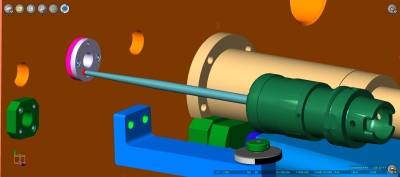
The latest CAM simulation software release from Hexagon Manufacturing Intelligence includes new and enhanced functionality giving users the ability to execute tasks for existing projects on a remote server. Based on client/server scheduler architecture, the new version of NCSIMUL’s machining module includes new automation functionality that gives the user wider control of their jobs on other devices by communicating with distant servers.
Philippe Legoupi, NCSIMUL technical director, says a dedicated GUI allows tasks such as simulation, cut analysis and 3D movies to be performed on any device. “Users can follow the status of the job and receive a notification when it’s complete.”
The Automation Module provides a number of significant benefits, including a guarantee that a full 100 percent of the program sent to the workshop is validated by the simulation. “For most minor modifications in the CAM, such as the number of passes, or changing the cutting conditions, the end user won’t verify the program because it’s too tedious – for example, starting the software, reloading the program and starting the simulation,” he said.
The system enables customers to implement their own automation rules according to constraints and production priorities. He adds that the tasks all feature in a command file, which also shows the parameters to use, and can be customized. It means customers can be sure that all program verification and simulation accurately follows requirements.
It also maximizes license usage. For example, if a manufacturer has just one license, they can use this module to postpone tasks with the scheduler, until lunchtimes or overnight. “Companies with several licenses don’t need to use the scheduler at all – the server starts automatically when there are enough licenses for interactive sessions.”
The high-end NCSIMUL MACHINE 2020.0, which detects NC programming errors and any potential collisions from the same NC code that drives the CNC machine, also contains enhancements to a variety of functions, including Probing and Optitool.
Probing: It is now possible to set specific simulation parameters for probing simulation during decoding. There is also the option to simplify the tool shape to reduce calculation times; default values can be defined into preferences; and interactive comments and ACNU functions can define any elements to ignore during the calculation of probing contact points.
Optitool: The latest version of NCSIMUL features an improvement of chips flow computation and display on each increment, and the flow can also be used for optimization as a limitation parameter.
The latest release of NCSIMUL’s flexible CNC programming module, 4CAM, also includes a number of items of new and enhanced functionality.
Sequences optimization:
- Dependencies computation displays the link between operations, allowing the user to know which ones create the initial stock
- Proposal of tools sequence reorganization to reduce the number of machine stops for changing inserts
Link between operation:
- Calculates, by iterations, the nearest link between operations which have the same tool orientation
It is now possible to import multiple files in one process for each group of operations, and the default settings are defined into preferences. “Also, the import can update existing trajectories, while keeping the options and repeat functions,” says Legoupi. “And a report displays the actions carried out during the import, such as updating, and adding and deleting operations.”
Other enhancements to NCSIMUL 4CAM include options within Scraps Management for computing intermediate stock and cut analysis, and the ability to write an interactive comment in the program; defining an origin on rotary axes; and managing tool sisters by writing a tool change code in the program for a selected operation, culminating in the machine loading the sister tool if required.
In conclusion, he says, NCSIMUL MACHINE continues to build users’ confidence that their parts will be accurately and swiftly validated offline, speeding up production, and optimizing resources and machinng results. “And updates in the latest NCSIMUL 4CAM module enrich the existing CAM process by simplifying CNC programming even further, while providing unparalleled flexibility on the shop floor. The software’s major benefit is that with one click users can change the target machine without any CAM reprogramming.”
Contact Details
Related Glossary Terms
- computer numerical control ( CNC)
computer numerical control ( CNC)
Microprocessor-based controller dedicated to a machine tool that permits the creation or modification of parts. Programmed numerical control activates the machine’s servos and spindle drives and controls the various machining operations. See DNC, direct numerical control; NC, numerical control.
- computer-aided manufacturing ( CAM)
computer-aided manufacturing ( CAM)
Use of computers to control machining and manufacturing processes.
- numerical control ( NC)
numerical control ( NC)
Any controlled equipment that allows an operator to program its movement by entering a series of coded numbers and symbols. See CNC, computer numerical control; DNC, direct numerical control.






